Family : Phoenicopteridae

Text © Dr. Gianfranco Colombo

English translation by Mario Beltramini
Present in austral Africa and in north-western India, the Lesser flamingo (Phoeniconaias minor) is the smallest and most numerous of the family © Giuseppe Mazza
The Lesser flamingo (Phoeniconaias minor Geoffroy Saint-Hilaire, 1798) belongs to the order of the Phoenicopteriformes and to the family of the Phoenicopteridae and is the smallest as well as the most numerous among all flamingoes.
The fact of being the smallest does not lack by sure of its own spectacular peculiarity due to the extraordinary bright pink colour that is much more marked and lively than its cognate and bigger Greater flamingo (Phoenicopterus roseus) much more diffused and so much praised.
It will certainly be due to the fact that only the last one appears in the European skies and so we see it as an extension of the African beauties on the European territory and as such in the human soul we try to emphasize the extraordinary nature of this presence but in the reality the lesser flamingo would enjoy a better consideration should it also have landed on our continent.
The concept of pink is nowadays traditionally linked to the flamingo but the difference in the hue and intensity of this colour in the two species is noted as soon as we observe one of those immense flocks that fly over the lakes of the Rift Valley, where the lesser flamingoes are easily distinguished with a much brighter and more lively pink wave and easily distinguishable from the others that even appear whitish in comparison.
Also the fact of being the most numerous has its own peculiarities.
Unluckily, as regularly happens on a regular basis, this bird is subject to a spectacular massacre that sees the death of thousands of specimens due to the modification of the waters where it lives.
The flamingoes live in highly alkaline waters, the best habitat for the growth of the Spirulina (Arthrospira platensis), an alga that stands among the main aliments of these birds.
In the few African lakes with these characteristics, placed mainly in the Great Rift Valley, often occur floodings with flow of a great quantity of rain water that midifies drastically their saline composition, interrupting immediately the cycle of production of these microalgae.
So, suddenly, in a few days, here is the main food disappearing with the foreseeable consequences.
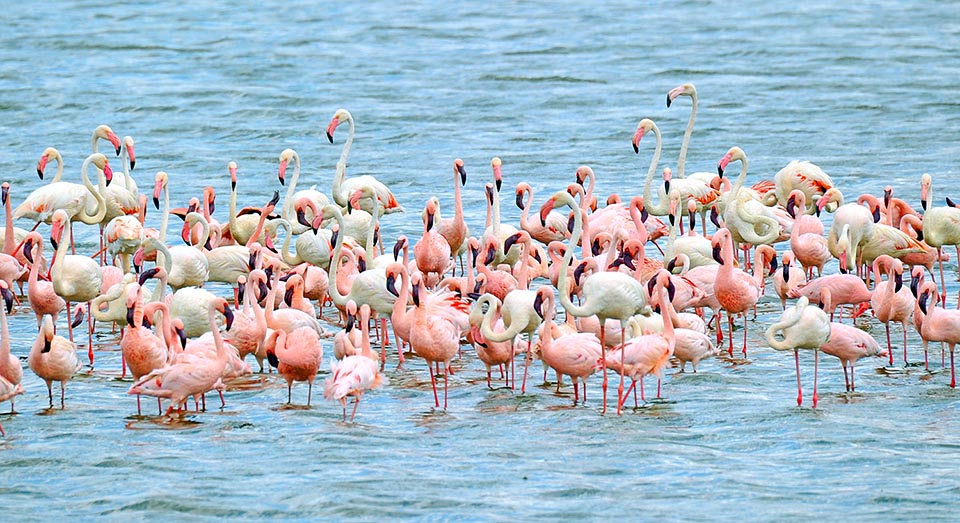
In this photo, taken at Bogoria lake in high Kenya, is mixed to the Greater flamingo (Phoenicopterus roseus) at home also in Europe, surely bigger and more faded © Gianfranco Colombo
The lake Bogoria in the high Kenya during the last years has seen the death of tens of thousands of these birds.
The etymology of the generic name Phoeniconaias gets its origin from the Greek “Phoinix” = red, carmine colour and “naias” = naiad, water nymph. The specific name minor means, in Latin, smaller with reference to its reduced size.
Colony of Phoeniconaias minor at Nakuru Lake, Kenya. For living needs very alkaline waters where the Arthrospira platensis abounds, an alga base of its diet © G. Mazza
As often occurs in the scientific classification, at times in an unmotivated or difficult to understand way for the many, also this bird has seen modified its genus to which has always been assigned (Phoenicopterus) and placed in a new and more exotic Phoeniconaias anyway as only species.
The white-pinkish livery reaches in the time of full nuptial livery a bright pink colour, with elegant reddish marks on the primary coverts and with carmine patches on the chest and on the body © Giuseppe Mazza
Here are some European vulgar names: in English, Lesser flamingo; in German, Zwergflamingo; in Spanish Flamenco Enano; in French Flamant nain; in Italian Fenicottero minore and in Portuguese Flamingo-pequeno.
Zoogeography
The lesser flamingo lives in southern Africa and in north-western India.
In Africa is present along the Rift Valley and in East Africa, from Sudan to South Africa, the western coasts of the Guinea Gulf from Senegal to Nigeria and from Angola to Namibia south in all austral Africa.
It is found also, isolated, in the Lake Chad.
In India is present in Gujarat in particular in the swamps of the Rann of Kutch.
The lesser flamingo is semi-sedentary with periodical movements inside the continent between the various alkaline lakes where it lives and that it reaches depending on the necessity of research of food or of the nidification place.
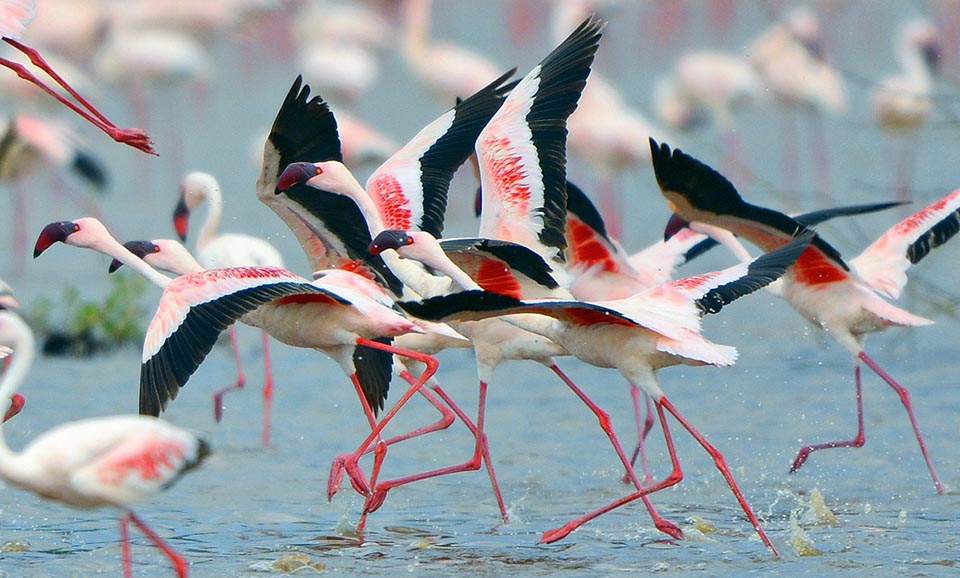
The tip of the remiges is black and forms an alar bar visible only in flight or at take off. The legs reach the 60 cm and erect the bird easily exceeds the metre © G. Colombo
Ecology-Habitat
The feeding of the lesser flamingo is highly specialized and is formed mainly by the algae Arthrospira, Oscillatoria, Lyngbya and Navicula spp. but also by very small shrimps and crustaceans, whose contents of coloured pigments confers them the typical brigh pink colouration.
The bill is a natural pump filtering thousands of litres of water per day, sucked and then pumped out with the very fast and endless movement of the robust, stocky and round tongue that acts as a piston © Gianfranco Colombo
The lesser flamingo is equipped with an exceptional bill, a natural pump that filtres thousands of litres of waters per day, holding between the very narrow laminae the tiny corpuscles that form their diet.
The water is practically aspirated and pumped out at the same time with a very fast and continuous movement of the robust, stocky and round tongue that operates exactly like the plunger of a hydraulic pump.
If we can observe the operation closely, besides the continuous gurgling sound produced by the water getting out through the narrow laminae, we can note also a light and vaporous foaming produced by the exit pressure of the liquid from the bill.
The bill of the lesser flamingoes has a strange shape with a neat angle at 90° at half of its length that corresponds to the base that is immersed on the surface of the water practically keeping the head upside down.
The presence of this bird is linked to the alkaline waters and is easily and mainly identifiable with the lakes Magadi, Bogoria, Nakuru in Kenya, Natron in Tanzania, Etosha Pan in Namibia, Kamfer Dam in South Africa, Aftout es Saheli in Mauritania, Rann of Kutch, Zinzuwadia and Purabcheria in India.
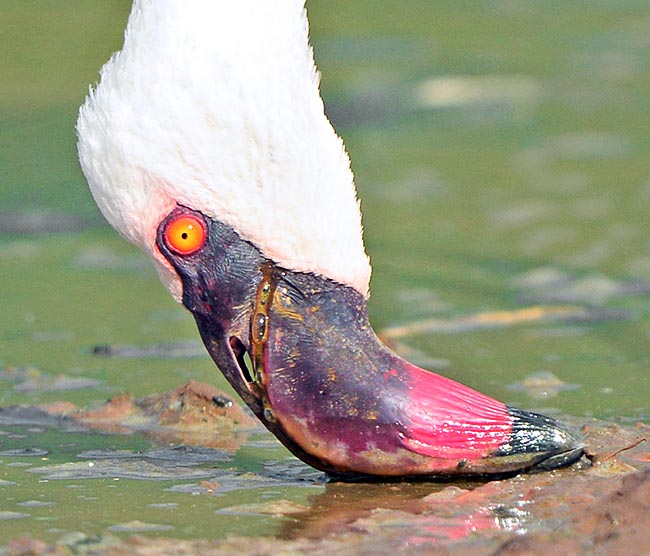
Special laminae hold the food in a continuous bubbly and vaporous gurgling © Gianfranco Colombo
The flamingo is linked also to a daily regular migration of a few hours taking it, at times, for tens of km looking for fresh water lakes in order to rinse paws and feathers.
Living in highly alkaline waters, on the paws and on the feathers take form encrustations of salts, that, in sime instances, especially in the young not yet capable to fly, form true and real concretions that weigh down the body thus rendering them unable to fly. The bathing in fresh water has rightly the aim of washing feathers and paws from these deposits.
With the young, once able to toddle in the water, is done a terrestrial migration, with the massive movement by walking of the whole nursery formed at times by hundred of thousands of young, towards that part of the lake having less alkaline waters.
Morpho-physiology
We have said that this flamingo is the smallest among all the members of its group. However, it has a remarkable size, such to reach a total length of 80 cm, excluding the long legs, a weight up to 2,5 kg and a wingspan of 100 cm. When erect on the paws, it exceeds the height of one metre. Easily distinguishable in the size and for the colour, brighter than that of the greater flamingo, only through a direct confrontation we can immediately recognize it as the features and the movements are perfectly similar.
Feeding if formed mainly by algae, but also by very small shrimps and crustaceans, whose contents of coloured pigments confers to these pretty birds the typical bright pink colouration © Giuseppe Mazza
On the burning African lakes the light and heat reflection is such that only vision remains that of a shapeless and reddish mass moving hopping in the area like a windswept tiny flame. Hard to know what species it is.
The livery has a strongly pinkish white colour, finally reaching, during the period of full nuptial livery, a very marked bright pink colour, with a reddish marking on the primary coverts and with touches of carmine colour on the chest and on the body.
The tip of the remiges is black and forms an alar bar visible only when flying.
The bill is dark red, apparently blackish, highly curved downward at half of its length, for the reasons already hinted, with incredibly bright red eyes and yellow pupil.
The legs may reach the 60 cm of length, and are fire red with webbed toes equipped with big black nails.
The neck is extremely long and thin so much to allow this bird to put the bill in water while standing upright on its legs. When flying we have the doubt as how a bird of this shape can stay in the air.
A very long neck stretched forward and slightly leaning down, as if its weight should be excessive for maintaining that position, with well evident massive bill which is kept high, proud and protruded forwards as if it were a “front” rudder.
Very long and filiform legs extending back as long as the neck and in the middle a small globose and rounded small body to balance the two extensions.
Like all waders it sleeps on a leg with the head under the wing © G. Mazza
The wings, then, are very narrow, as a hawk, with rapid beat, continuous to guarantee the precarious balance and the reduced lift of this odd aerial structure. It’s a difficult to forget spectacle. Nevertheless, the lesser flamingo is an excellent flyer, capacity of which takes advantage during its continental errations looking for places where to settle. These migrations are usually nocturnal.
Ethology-Reproductive Biology
The social life of the lesser flamingo is well known. There is no naturalistic document about Africa that does not show these enormous flocks of birds while flying over the lakes of the Great Rift Valley.
Pink waves spreading through the air or shrinking in front of the lens during the aerial passages for the film shooting and that from top do not give the least idea of how many they can be.
It is almost impossible to observe single or very few isolated specimens of this bird if not in the case of individuals in poor health.
At times take form flocks of hundreds of thousands of specimens with concentrations such to make disappear from view the surface of the lake where they have settled. The Lake Bogoria sometimes counts more than 1 million of individuals without taking anything away from the other nearby lakes.
The lesser flamingo nidifies in very vast colonies but concentrated in very few well known and likewise well monitored locations, though being the most numerous among the world flamingoes, it suffers from the typical risks of the endemic birds or, as this is the case, with much reduced areas.
The risk, as it has been verified during the last decades, is very high as it would suffice that a pair of the frequented sites suffers from industrial pollution or atmospheric accidents capable to modify the biological structure of the waters, to destroy entire populations formed by hundreds of thousands of specimens.
For this reason, the lesser flamingo besides being the most numerous, is also the most controlled and consequently placed among the species subject to “particular risk”.
The species is monogamous and the choice of the partner takes place in a social way with group representations seeing a dance in unison half leg in the water, of hundreds of specimens moving back and forth in the same direction with perfect synchrony as if it were a well-studied ballet. The neck is stretched to the utmost upwards, accompanied by wing beats that evidence even more the red colour of their livery.
The nest is a mass of mud and feathers standing several cm from the ground, shaped like a truncated cone in whose cup placed on the vertex, is laid the only one egg. Both partners alternate in hatching which lasts 28 days.
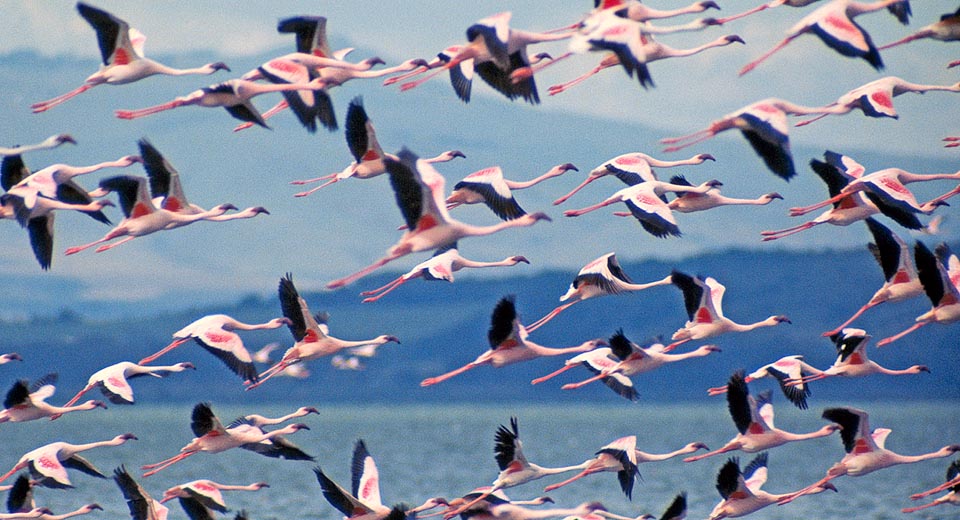
Every day flocks of flamingoes migrate for few hours from the salt waters where the find food to lakes or ponds of fresh water © Giuseppe Mazza
The chicks are nourished by the parents with a very nutritious pap regurgitated directly into the bill, formed by the predigested microorganisms they eat. After one week the chicks are capable to walk and to reach the nursery where they will live for the following 12 weeks, until when they will be capable to fly off.
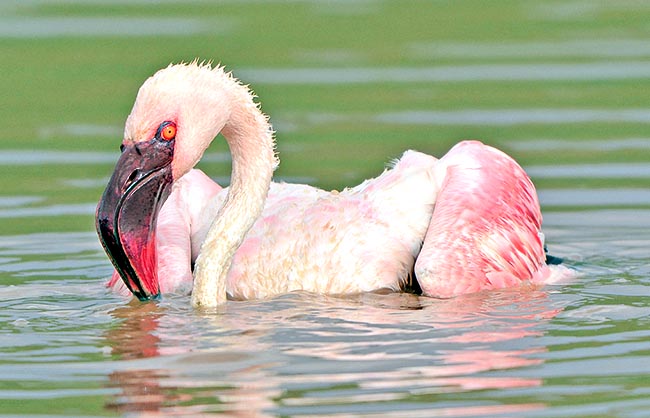
In fact they must regularly wash legs and feathers, like this swimming flamingo, not to get too much weight with dangerous saline encrustations that, cumulating, might render them unable to fly © Gianfranco Colombo
The sexual maturity is reached by the second year of age and the lifespan may exceed the 50 years.
It is a bird who adapts very well to the life in nature parks and zoos even if after short time they lose almost completely the nice pink colour typical of their plumage.
When in the wild it has many natural foes, from the hyenas to the jackals and the baboons by land and eagles, eagle-owls and Marabou storks (Leptoptilos crumenifer) by air. In the past also the man has contributed in the hunt of this bird seen the goodness of its tongue and its eggs. Practices now fortunately almost forgotten.
Synonyms
Phoenicopterus minor Geoffroy Saint-Hilaire, 1798.
